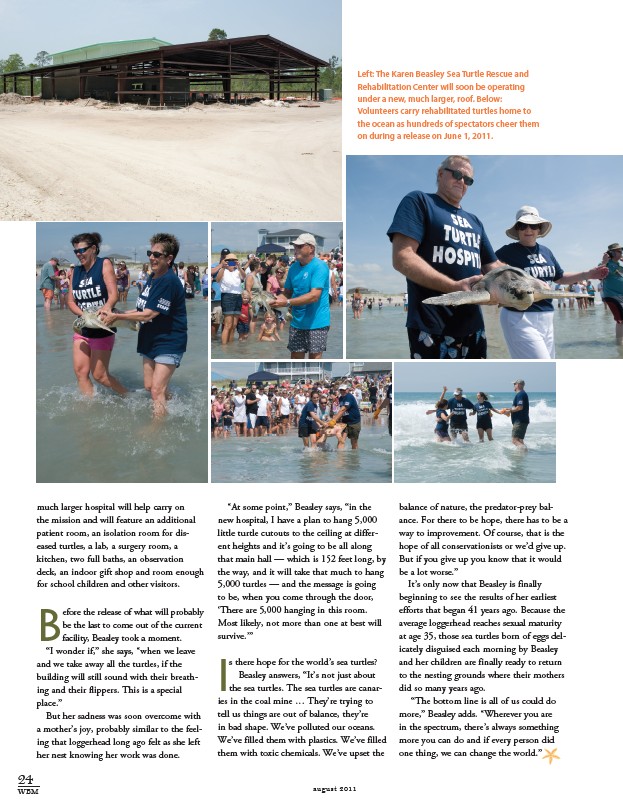
much larger hospital will help carry on
the mission and will feature an additional
patient room, an isolation room for diseased
turtles, a lab, a surgery room, a
kitchen, two full baths, an observation
deck, an indoor gift shop and room enough
for school children and other visitors.
Before the release of what will probably
be the last to come out of the current
facility, Beasley took a moment.
“I wonder if,” she says, “when we leave
and we take away all the turtles, if the
building will still sound with their breathing
and their flippers. This is a special
place.”
But her sadness was soon overcome with
a mother’s joy, probably similar to the feeling
that loggerhead long ago felt as she left
her nest knowing her work was done.
Left: The Karen Beasley Sea Turtle Rescue and
Rehabilitation Center will soon be operating
under a new, much larger, roof. Below:
Volunteers carry rehabilitated turtles home to
the ocean as hundreds of spectators cheer them
on during a release on June 1, 2011.
“At some point,” Beasley says, “in the
new hospital, I have a plan to hang 5,000
little turtle cutouts to the ceiling at different
heights and it’s going to be all along
that main hall — which is 152 feet long, by
the way, and it will take that much to hang
5,000 turtles — and the message is going
to be, when you come through the door,
‘There are 5,000 hanging in this room.
Most likely, not more than one at best will
survive.’”
Is there hope for the world’s sea turtles?
Beasley answers, “It’s not just about
the sea turtles. The sea turtles are canaries
in the coal mine … They’re trying to
tell us things are out of balance, they’re
in bad shape. We’ve polluted our oceans.
We’ve filled them with plastics. We’ve filled
them with toxic chemicals. We’ve upset the
24
WBM august 2011
balance of nature, the predator-prey balance.
For there to be hope, there has to be a
way to improvement. Of course, that is the
hope of all conservationists or we’d give up.
But if you give up you know that it would
be a lot worse.”
It’s only now that Beasley is finally
beginning to see the results of her earliest
efforts that began 41 years ago. Because the
average loggerhead reaches sexual maturity
at age 35, those sea turtles born of eggs delicately
disguised each morning by Beasley
and her children are finally ready to return
to the nesting grounds where their mothers
did so many years ago.
“The bottom line is all of us could do
more,” Beasley adds. “Wherever you are
in the spectrum, there’s always something
more you can do and if every person did
one thing, we can change the world.”